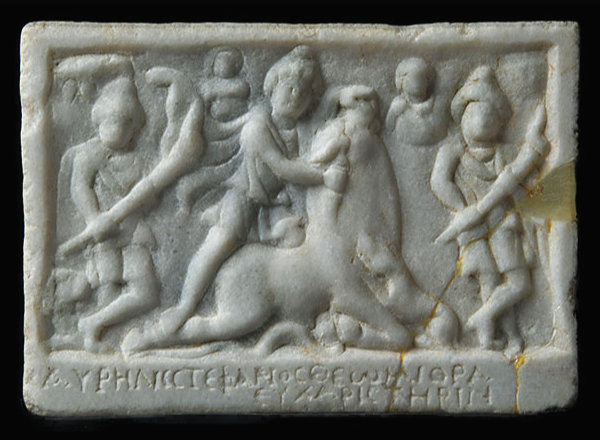
Αὐρήλιος Στέφανος
Alias Aurelius Stephanos
Greek-speaking member of the community of Mithras followers from Apulum in the 2nd century.
Biography
of Αὐρήλιος Στέφανος
- Αὐρήλιος Στέφανος was a syndexios.
- Active c. 3rd century in Apulum, Dacia superior (Dacia).
TNMP 235
Three other, small-sized monuments could also have come from the territory of the Colonia Aurelia Apulensis. The altar of Lucanus – a slave or libertus – was discovered in 1868 during the construction of the first railway in the modern city of Alba Iulia, which crossed and severely damaged the northern and central parts of the Roman city.
The two reliefs have an uncertain provenance, but some of their features could suggest that Aurelius Stephanos and Euhemerus were also members of one of the Mithraic groups of the Municipium Aurelium Apulensis/Colonia Aurelia Apulensis. Both of them are of modest social status from the Greek-speaking part of the Empire, similar to the members of the Mithraic groups presented above. This could suggest that in the area of the Colonia Aurelia Apulensis – at least in the 2nd century AD – the Mithraic groups had also a specific, ethnic or cultural level besides the familial or economic bonds.
It is not possible to reconstruct the origin of these groups or their members: it is uncertain whether they arrived in Dacia as ready-formed groups, or whether the formation of these groups was influenced by some local individuals and specific tendencies and circumstances developed here. The economic connections attested in the northern part of the civil settlement, however, suggest that these groups had a rich social network outside of the province, which could pre-date their Dacian presence.
The case of the signum dedicated by Secundinus also serves as an argument for the extra-provincial links of the first Mithraic groups from the civil settlement.
References
- Bricault; Roy (2021) Les cultes de Mithra dans l'Empire Romain
Mentions
Tauroctony of Aurelios Stephanos from Sibiu
TNMM 667
This relief of Mithras killing the bull is unique in the Apulum Mithraic repertoire because of its inscription in Greek.


Comments
Add a comment